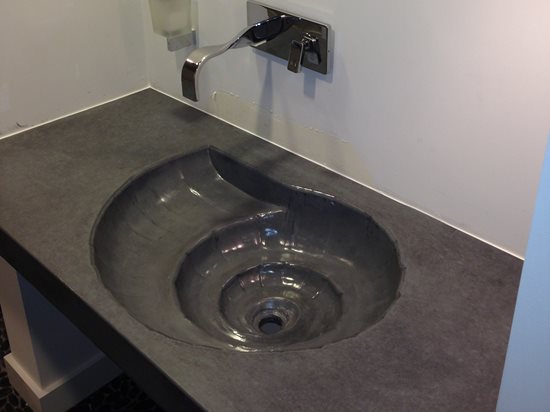- Sinks and Vessels Home
- Concrete Sink Pictures
- Integral Sinks
- Vessel Sinks
- Farmhouse & Trough Sinks: Plus other popular styles
- Design Ideas
- Bathroom Countertops: Designs and ideas for using concrete in the bathroom
- Bathroom Remodeling: Ideas for using concrete in bathroom remodels
- Concrete Sink and Tub Projects: Behind-the-scenes info and photos
- Six Design Ideas for Concrete Tubs
- Facts About Concrete Sinks
- How to Seal a Concrete Sink
- Using Prefab Sink Molds: How concrete sinks are made
Ammonite Sink
Project submitted by Chris Frazer, DC Custom Concrete, San Diego, Calif.Where did the inspiration for this sink come from? Why an ammonite basin?Our client was designing a modern apartment complex that had a need for something natural and organic to break away from the sharp contemporary lines of the building’s architecture.
What are the dimensions of the sink?The sink measure 5 feet by 2 feet and is 4" thick.
How was it formed?We used a standard wet cast method with a melamine form. The shape of the ammonite mold was sculpted using plaster.
What type of mix was used?A wet cast GFRC hybrid was our mix of choice.
What coloring products were used?A little black pigment was added to slightly darken the grey cement.
Were any special finishing techniques used?The sink was lightly sanded by hand, then sealed heavily with acrylic water based sealer.
How was it installed to get the floating effect?This was a standard floating install. We used 2.5" angle iron fastened to 3 walls. Then the sink was glued to angle iron.
What was most challenging about this project?Hands down building the ammonite mold. My partner did it by hand and it took him many hours!
ContractorChris Frazer
DC Custom Concrete, San Diego, Calif.
www.dccustomconcrete.com
Follow them: Facebook | Instagram
Submit Your Own Project Photos
 Slot Drain Ramp Sink Mold
72" with internal reinforcement
Slot Drain Ramp Sink Mold
72" with internal reinforcement
 Rectangle Sink Mold
Internally reinforced. Ships in 2 to 3 business days.
Rectangle Sink Mold
Internally reinforced. Ships in 2 to 3 business days.
 Mold Making Kit
Create custom rubber molds for concrete casting
Mold Making Kit
Create custom rubber molds for concrete casting





